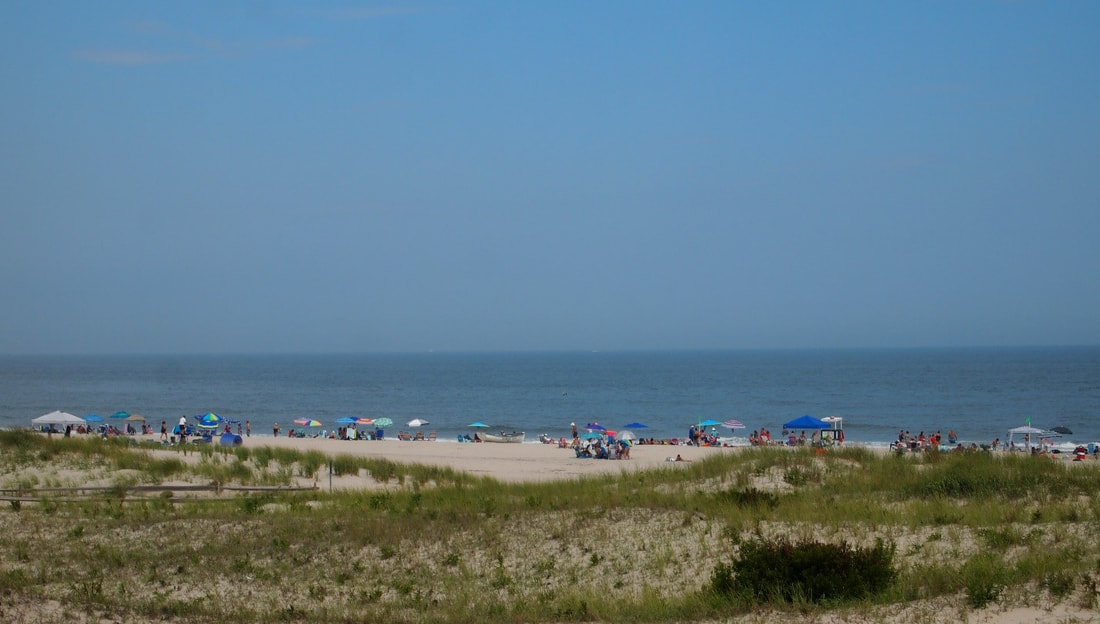Today is a tranquil morning at the beach with a light breeze from the southwest. The sun is so bright reflecting off the water that I must squint without my sunglasses. The wind powers a mere ripple of waves that break close to shore, giving rise to the soothing sound of the surf. There are beachcombers spaced appropriately for physical distancing during the coronavirus epidemic, a reminder of the hidden danger. Catbirds are chirping and gulls vocalizing as an airplane pulls a banner saying, “Care for each other – Mask and social distance.” A lifeguard silently moves the oars on his rowboat along the boundary between ocean and land. Powerboats speed by, disrupting the calmness with the sound of roaring engines. They quickly leave, returning the environment to a state of peace. A few frustrated surfers patiently await a swell worth riding. There is nothing in the idyllic scene that suggests planet earth is in danger. It is easy to be lulled into complacency.
The ocean, however, is sounding alarms. Unseen from the vantage of the dunes, the ocean is being impacted by powerful forces of nature including humanity. Rising water temperatures forebode more and stronger storms. As recently as last week a storm generated serious damage as it moved up the east coast of the United States. These storms are becoming both more frequent and more intense as water temperature and levels rise in response to climate change.
The elements stressing the oceans are complex. They are so complex that a blog entry fails to do it justice. Rather than considering climate change as a sequence of actions, it is more convergent in nature. Picture a soccer ball. Each facet of the ball is impacted whenever any one facet is kicked. For the layman in climate science, this is the most daunting challenge – showing how multiple conditions affect each other.
Fortunately, there are resources to assist with this story. “The Ocean Foundation (TOF)” allows a layered approach. Their web segment, “The Basics of Climate Change and the Ocean” is an excellent tutorial. Each paragraph distills significant points from linked scholarly studies. The guide is divided into the following section:
1. Introduction
2. The Basics of Climate Change and the Ocean
3. Coastal and Ocean Species Migration due to Climate Change
4. Hypoxia (Dead Zones)
5. The Effects of Warming Waters
6. Marine Biodiversity Loss due to Climate Change
7. The Effects of Climate Change on Coral Reefs
8. The Effects of Climate Change on the Arctic and Antarctic
9. Policy and Government Publications
10. Looking for More? (Additional Resources)
The common denominator for all of these is human interaction. Because of this, it’s clear that behavioral changes will help mitigate the trauma that is now bit by bit destroying the oceans’ ability to perform their restorative actions such as serving as a “heat sink” or absorbing excess carbon dioxide.
In the same way the sun clears away the morning fog, groups like “The Ocean Foundation” allow non-scientists to peel away the veil of issues that on a warm summer day on the beach are quite invisible.
The ocean, however, is sounding alarms. Unseen from the vantage of the dunes, the ocean is being impacted by powerful forces of nature including humanity. Rising water temperatures forebode more and stronger storms. As recently as last week a storm generated serious damage as it moved up the east coast of the United States. These storms are becoming both more frequent and more intense as water temperature and levels rise in response to climate change.
The elements stressing the oceans are complex. They are so complex that a blog entry fails to do it justice. Rather than considering climate change as a sequence of actions, it is more convergent in nature. Picture a soccer ball. Each facet of the ball is impacted whenever any one facet is kicked. For the layman in climate science, this is the most daunting challenge – showing how multiple conditions affect each other.
Fortunately, there are resources to assist with this story. “The Ocean Foundation (TOF)” allows a layered approach. Their web segment, “The Basics of Climate Change and the Ocean” is an excellent tutorial. Each paragraph distills significant points from linked scholarly studies. The guide is divided into the following section:
1. Introduction
2. The Basics of Climate Change and the Ocean
3. Coastal and Ocean Species Migration due to Climate Change
4. Hypoxia (Dead Zones)
5. The Effects of Warming Waters
6. Marine Biodiversity Loss due to Climate Change
7. The Effects of Climate Change on Coral Reefs
8. The Effects of Climate Change on the Arctic and Antarctic
9. Policy and Government Publications
10. Looking for More? (Additional Resources)
The common denominator for all of these is human interaction. Because of this, it’s clear that behavioral changes will help mitigate the trauma that is now bit by bit destroying the oceans’ ability to perform their restorative actions such as serving as a “heat sink” or absorbing excess carbon dioxide.
In the same way the sun clears away the morning fog, groups like “The Ocean Foundation” allow non-scientists to peel away the veil of issues that on a warm summer day on the beach are quite invisible.


 RSS Feed
RSS Feed